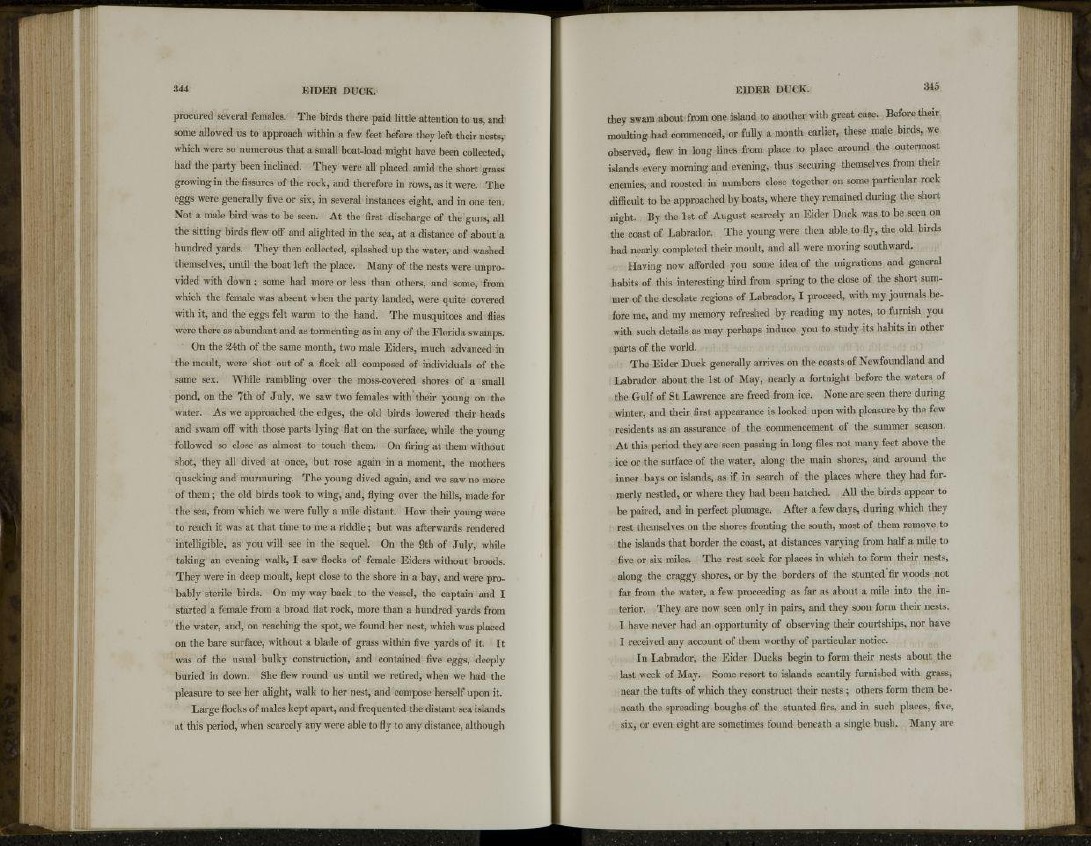
procured several females. The birds there paid little attention to us, and
some allowed us to approach within a few feet before they left their nests,
which were so numerous that a small boat-load might have been collected,
had the party been inclined. They were all placed amid the short grass
growing in the fissures of the rock, and therefore in rows, as it were. The
eggs were generally five or six, in several instances eight, and in one ten.
Not a male bird was to be seen. At the first discharge of the guns, all
the sitting birds flew off and alighted in the sea, at a distance of about a
hundred yards. They then collected, splashed up the water, and washed
themselves, until the boat left the place. Many of the nests were unprovided
with down; some had more or less than others, and some, from
which the female was absent when the party landed, were quite covered
with it, and the eggs felt warm to the hand. The musquitoes and flies
were there as abundant and as tormenting as in any of the Florida swamps.
On the 24th of the same month, two male Eiders, much advanced in
the moult, were shot out of a flock all composed of individuals of the
same sex. While rambling over the moss-covered shores of a small
pond, on the 7th of July, we saw two females with their young on the
water. As we approached the edges, the old birds lowered their heads
and swam off with those parts lying flat on the surface, while the young
followed so close as almost to touch them. On firing at them without
shot, they all dived at once, but rose again in a moment, the mothers
quacking and murmuring. The young dived again, and we saw no more
of them ; the old birds took to wing, and, flying over the hills, made for
the sea, from which we were fully a mile distant. How their young were
to reach it was at that time to me a riddle ; but was afterwards rendered
intelligible, as you will see in the sequel. On the 9th of July, while
taking an evening walk, I saw flocks of female Eiders without broods.
They were in deep moult, kept close to the shore in a bay, and were probably
sterile birds. On my way back to the vessel, the captain and I
started a female from a broad flat rock, more than a hundred yards from
the water, and, on reaching the spot, we found her nest, which was placed
on the bare surface, without a blade of grass within five yards of it. It
was of the usual bulky construction, and contained five eggs, deeply
buried in down. She flew round us until we retired, when we had the
pleasure to see her alight, walk to her nest, and compose herself upon it.
Large flocks of males kept apart, and frequented the distant sea islands
at this period, when scarcely any were able to fly to any distance, although
they swam about from one island to another with great ease. Before their
moulting had commenced, or fully a month earlier, these male birds, we
observed, flew in long lines from place to place around the outermost
islands every morning and evening, thus securing themselves from their
enemies, and roosted in numbers close together on some particular rock
difficult to be approached by boats, where they remained during the short
night. By the 1st of August scarcely an Eider Duck was to be seen on
the coast of Labrador. The young were then able to fly, the old birds
had nearly completed their moult, and all were moving southward.
Having now afforded you some idea of the migrations and general
habits of this interesting bird from spring to the close of the short summer
of the desolate regions of Labrador, I proceed, with my journals before
me, and my memory refreshed by reading my notes, to furnish you
with such details as may perhaps induce you to study its habits in other
parts of the world.
The Eider Duck generally arrives on the coasts of Newfoundland and
Labrador about the 1st of May, nearly a fortnight before the waters of
the Gulf of St Lawrence are freed from ice. None are seen there during
winter, and their first appearance is looked upon with pleasure by the few
residents as an assurance of the commencement of the summer season.
At this period they are seen passing in long files not many feet above the
ice or the surface of the water, along the main shores, and around the
inner bays or islands, as if in search of the places where they had formerly
nestled, or where they had been hatched. All the birds appear to
be paired, and in perfect plumage. After a few days, during which they
rest themselves on the shores fronting the south, most of them remove to
the islands that border the coast, at distances varying from half a mile to
five or six miles. The rest seek for places in which to form their nests,
along the craggy shores, or by the borders of the stunted fir woods not
far from the water, a few proceeding as far as about a mile into the interior.
They are now seen only in pairs, and they soon form their nests.
I have never had an opportunity of observing their courtships, nor have
I received any account of them worthy of particular notice.
In Labrador, the Eider Ducks begin to form their nests about the
last week of May. Some resort to islands scantily furnished with grass,
near the tufts of which they construct their nests ; others form them beneath
the spreading boughs of the stunted firs, and in such places, five,
six, or even eight are sometimes found beneath a single bush. Many are